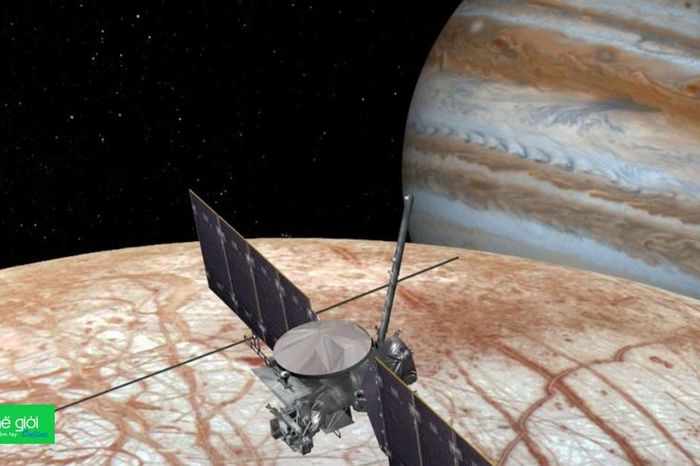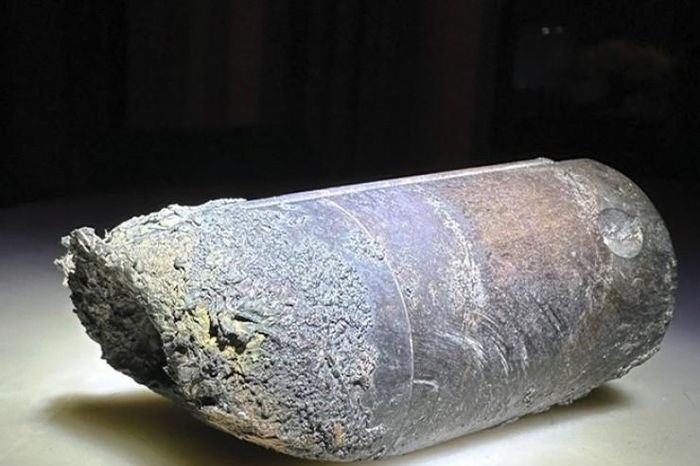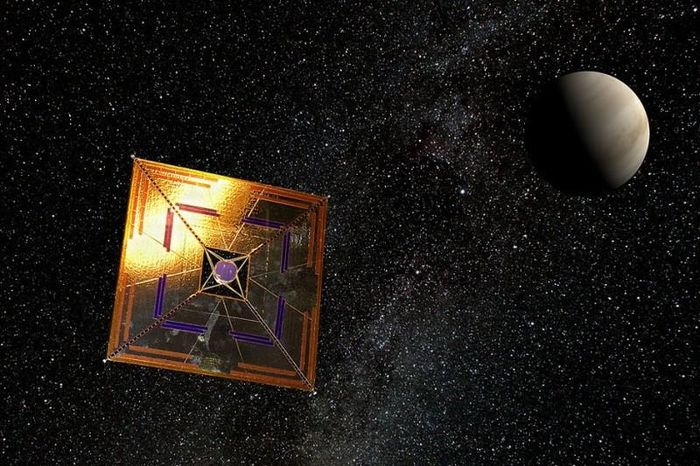Garbage falls from space and hits civilian homes in the US

According to Wired , on March 8, an unidentified object fell from the sky onto the roof of Mr. Alejandro Otero's house. NASA suspects that they may have come from the International Space Station (ISS).
At the time of the incident, Otero was not home but his son witnessed the incident. The family's security camera also recorded sound from the accident at 2:34 p.m. on March 8 (local time).
This is important information because it coincides with the time the US Space Command recorded the movement of a piece of space debris from the space station. At that time, the object was moving across the Gulf of Mexico, toward southwest Florida.
The space junk suspected of causing the accident in Florida includes expired batteries from the ISS, which were placed in a cargo box and released to Earth under supervision from experts on the research station. However, due to many delay factors, NASA jettisoned them from the space station in 2021 without a monitor.
NASA recovered debris from the house to analyze its origin. The space trash container mentioned above includes 9 unused batteries from the space station's electrical system, weighing more than 2.6 tons. In terms of size, it is twice as tall as a standard refrigerator.
It is important to note that objects of equal or greater mass frequently fall to Earth in pre-calculated orbits. In particular, they are often broken satellites or used booster stages.
In a post on social network
According to Michelle Hanlon, Executive Director of the Center for Aviation and Space Law at the University of Mississippi, Mr. Otero and the insurance company in charge can make a claim if the unidentified object above is on property. owned by NASA.
Before the above incident, a NASA spokesperson at the Johnson Space Center said research agencies 'conducted a thorough analysis of the debris on the pallet and determined that it would reenter the atmosphere. Earth's atmosphere harmlessly'.
However, research from other space experts contains a lot of information that does not coincide with NASA's statement. The Aerospace Corporation, a federally funded research and development center, says the 'rule of thumb' is that 20-40% of the mass of a large object from space will reach the ground.
The exact percentage depends on the object's design, but the nickel-hydrogen batteries used on the ISS are made of a fairly high density metal.
In addition, the European Space Agency also admitted that some debris from this mass of garbage may have fallen to the ground.
You should read it
- Here's your chance to design a NASA payload for a Roomba-sized moon rover
- NASA opens the entire library of photos, videos and audio for free, anyone can see
- NASA will prioritize the recruitment of experienced scientists in blockchain and cryptocurrency
- NASA's top secret inventions have just been revealed
- NASA launches new Sun tracking tool
- Why didn't NASA intend to return to the Moon?
- How to watch NASA and Russia launch a new crew to the ISS on Thursday
- NASA's Internet speed rumor reaches 91 Gb / s, is it true to download movies in 1 second?
May be interested
- The most exotic waterfalls in the world
 blood waterfall, fire waterfall or horizontal waterfall ... are strange but no less spectacular waterfalls, which have a special attraction for those who love to explore.
blood waterfall, fire waterfall or horizontal waterfall ... are strange but no less spectacular waterfalls, which have a special attraction for those who love to explore. - 6 steps to 'hide' garbage on Windows?
 hidden garbage or cache are data in the previous session of applications, programs that the operating system saves to make loading data in later sessions faster. it will swell over time if you leave it alone and waste memory and slow down the process. therefore, to regain space for hard drive and speed up the computer, you can refer to the cleaning steps below of tipsmake.com.
hidden garbage or cache are data in the previous session of applications, programs that the operating system saves to make loading data in later sessions faster. it will swell over time if you leave it alone and waste memory and slow down the process. therefore, to regain space for hard drive and speed up the computer, you can refer to the cleaning steps below of tipsmake.com. - The 'Blood Falls' in Antarctica, hundreds of years of mystery has been decoded
 blood-red liquid filled with spills flowing from the glacier pouring into bonney lake is called blood falls, which stands out from the white landscape of antarctica which is a mystery that scientists always want to look too transparent over a century ago.
blood-red liquid filled with spills flowing from the glacier pouring into bonney lake is called blood falls, which stands out from the white landscape of antarctica which is a mystery that scientists always want to look too transparent over a century ago. - Use kitchen garbage to recycle into fertilizer for home vegetable garden
 make use of waste, turn them into fertilizer for vegetable gardens on the rooftop. that is how the street farmers are doing to deal with the current dirty food accident.
make use of waste, turn them into fertilizer for vegetable gardens on the rooftop. that is how the street farmers are doing to deal with the current dirty food accident. - Trick to delete junk files to free up space and cache iPhone, iPad
 after a period of use, you will notice that your iphone, or ipad, is getting slower and smaller, while the remaining space is too small. it's time you need to clean up your iphone, ipad by deleting unnecessary junk files to free up the occupied space.
after a period of use, you will notice that your iphone, or ipad, is getting slower and smaller, while the remaining space is too small. it's time you need to clean up your iphone, ipad by deleting unnecessary junk files to free up the occupied space. - Elon Musk has just released an extremely EDM music song on SoundCloud
 friday is usually the time when artists release new hits, and among the hits this friday, there's a piece from elon musk.
friday is usually the time when artists release new hits, and among the hits this friday, there's a piece from elon musk. - Guide fake Fanpage reports on Facebook
 fanpages with garbage content are not lacking on facebook and cause discomfort, not lightly for users. so how do i get them off facbeook even if you don't like it?
fanpages with garbage content are not lacking on facebook and cause discomfort, not lightly for users. so how do i get them off facbeook even if you don't like it? - What should I do when I find out that I own a spam SIM?
 after checking the phone sim by sending a message with tttb to the beginning of 1414, many dozen fire users discovered that they were subscribers of many numbers, but they did not register personal information for the number. that subscriber, and when contacting the switchboard, it is notified that it is a garbage sim.
after checking the phone sim by sending a message with tttb to the beginning of 1414, many dozen fire users discovered that they were subscribers of many numbers, but they did not register personal information for the number. that subscriber, and when contacting the switchboard, it is notified that it is a garbage sim. - Miracle: iPhone free fall from a height of 300 meters still 'survives'
 in just the past few weeks, two iphones have set an incredible record when falling from a height of 137m from one of the highest revolutions in orlando, usa and another dropped from a height of 304m from an aircraft and still normal operation.
in just the past few weeks, two iphones have set an incredible record when falling from a height of 137m from one of the highest revolutions in orlando, usa and another dropped from a height of 304m from an aircraft and still normal operation. - The iPhone is so sticky because of the water and this is the unique way this guy thought of 'remembering his friends'
 when you own an iphone, many people often fear their beloved comrades will one day have trouble. accidental accidents such as falling, water, battery damage ... may crash at any time, causing your iphone to be damaged and therefore tens of millions of dollars without playing.
when you own an iphone, many people often fear their beloved comrades will one day have trouble. accidental accidents such as falling, water, battery damage ... may crash at any time, causing your iphone to be damaged and therefore tens of millions of dollars without playing.










 'Hot' race to design a self-propelled vehicle on the Moon for NASA
'Hot' race to design a self-propelled vehicle on the Moon for NASA Anxiously awaiting the discovery of life on the moon 2.6 billion km from Earth
Anxiously awaiting the discovery of life on the moon 2.6 billion km from Earth Space junk from the ISS fell on a house in Florida
Space junk from the ISS fell on a house in Florida NASA chooses 3 companies to design lunar rovers for Artemis astronauts
NASA chooses 3 companies to design lunar rovers for Artemis astronauts NASA develops 'space sailboat' using solar energy
NASA develops 'space sailboat' using solar energy New Zealand strengthens cooperation with NASA to promote the space industry
New Zealand strengthens cooperation with NASA to promote the space industry